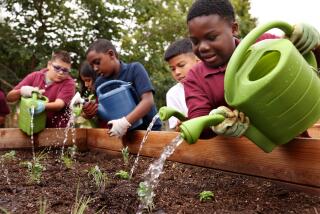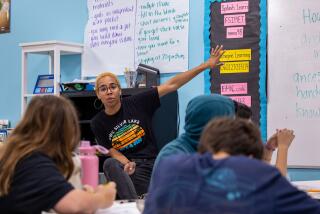The Keys to Learning : Experimental Music Program at Hardy Getting Rave Reviews
For 10-year-old Trung Tran, the lack of a piano for practice at home is the only downside to the innovative new music class that he and his classmates take at Hardy Elementary School.
But that hasnât dimmed his enthusiasm for the weekly instruction in international song, musical rhythm and pattern on professional-quality synthesizers, as well as keyboard practice and song-writing.
Tran has persuaded his father to take him each Saturday to the National City Fedco, where the fifth-grader busily practices the previous weekâs lessons on the storeâs musical instruments while his father shops.
Such is the effect that the experimental course in music and creativity, now in its third month, is having at the small school neighboring San Diego State University.
Through the generosity of philanthropist Muriel Gluck, Hardy Principal Gail Guth is tapping the talents of two local musicians, both to show the schoolâs 328 students the creativity possible through music and to enhance their enjoyment of academics in general.
The experimental program, if successful, could prove a potent example for a turnaround in elementary music education--long neglected not only in San Diego but throughout the United States--through a marriage of computer technology and a fresh new curriculum.
Once a week, each class at Hardy--from kindergarten through fifth--files into the computer lab where musical artists-in-residence Carl Hermanns and Gary Stokes put the students through a fast-paced 40 minutes about music.
Key to their efforts are the 17 Roland synthesizers, at which two students each can hear and make music from all over the world. The equipment, worth about $23,000 and protected in a specially secured classroom, is being rented for $432 a month.
District fine arts education director Kay Wagner hired Hermanns and Stokes using a small portion of Gluckâs $3.75-million grant and then has funded the music project out of her own budget. As far as Wagner knows, no other district in the nation has designed an elementary program around keyboard synthesizers, which can replicate almost any kind of music through computer technology.
Already, teachers at Hardy, who laud the program for motivating the children and for tying into language and science skills, are trying to interest businesses in their Montezuma Mesa neighborhood into providing an endowment so the class can become a permanent fixture.
âItâs a real credit to Carl and Gary,â teacher Art Geisler said. âAmong other things, the kids learn how to listen.â
On Monday, fourth- and fifth-grade students from Jack Shriverâs class reviewed the way to find the middle C key on their keyboards and then practiced ensemble-style, using their index fingers, the playing of each white key four times from middle C to the next higher C key. As the students moved from key to key, Hermanns clapped his hands together, steadily increasing the beat.
âOK, you guys found out we didnât keep to a steady tempo,â he said to wide-eyed smiles. âThis time, feel the tempo with your feet as well.â And the group busily tapped their feet as they ran their fingers up the keyboard a second time.
Then Hermanns and Stokes showed them how to play using the entire hand, keeping the thumb flat on middle C while gently curling the four fingers onto the adjoining keys. As a prompt, Hermanns played a little segment of a Michael Jackson song to tempt them into experimenting with sharps and flats as well.
âSee, itâs black, black, black, white, white,â Hermanns said, splitting the class into red and yellow teams, letting one team practice, using earphones, while the other team learned the names of the keys--from A through G--and how to distinguish sharps and flats.
Earlier, the class had listened to a Linda Ronstadt rendition of a Mexican love ballad, a recording on which her words were repeated to the same melody by a male singer accompanying her.
âWhat does this remind us of?â Hermanns asked the students, with several recalling the African âresponseâ songs they had heard the previous week. The class stood in a group and swayed from side to side, moving their feet to the beat of Ronstadtâs mariachi band accompaniment while Hermanns pointed out Mexico on the wall map.
âBeating out the rhythm with your feet is also a good way to (look natural) when you want to dance,â Hermanns reminded them, as several students continued to sway to the beat as they returned to their desks.
Later, Hermanns and Stokes explained the theory behind the class.
âWe want to show kids that music is a way to be creative, to be expressive, but also a way to boost self-esteem, and to affect other skills like math and reading as well,â said Hermanns, who has conducted Summer Pops programs for the San Diego Symphony as well as coordinating its school concert programs.
âThe kids learn that they also need a strong framework, that discipline comes right along with freedom in music, that there is work to do, that you donât get immediate gratification all the time.â
Stokes told of one student who wanted to know what button on the synthesizer she would press to hear the Michael Jackson rhythm.
âI realized that she wanted not just the (background) sound but thought you could push a button and get the whole song done for you,â Stokes said.
Hermanns said the program deliberately emphasizes students playing music first and then learning some of the reasons why the sounds develop the way they do.
âWhile doing it, while playing a Michael Jackson chord, for example, I throw out the concept of tempo, so that they are learning naturally while doing. We make them concentrate for a while on a new idea, then letting them play around a bit.â
Hermanns and Stokes, a jazz musician by training, vary the curriculum slightly depending on grade level, giving students in lower grades more rhythm and song work and fewer concepts.
The schoolâs regular teachers are unanimous in their praise.
âIâm teaching all my science through songs,â said Irene Harris who teaches fourth and fifth grades. âWe sang songs about the thermometer, about the rain cycle and now we are singing about anatomy . . . it beats giving them another work sheet.â
The students are sold on the class, and some persuaded their parents to buy small synthesizers as Christmas presents.
âI like experimenting with the different sounds,â fifth-grader Nathaniel Russ said, âespecially the âironworksâ sound, which sounds like a hammer and a nail.â
Tran said he notices now that basketballs and tennis balls âhave a rhythmâ when they bounce or when you kick them. And Cassie Mahoney, a fourth-grader, said she has a better appreciation for the piano lessons her grandmother gives her on Wednesdays.
âBefore, I used to say, âWhat is this?â â about the idea of lessons, Mahoney said.
Given the short duration of many experimental programs in the school district, Hardy teachers are apprehensive about whether the program will continue beyond its guarantee of one-year funding. The school is trying to find a âwhite knightâ to guarantee the program by purchasing the equipment for $23,000 in return for having the computer lab named for the donor.
âWagner and Gluck have been extremely generous, but we donât want this to be at the whim of the districtâs priorities,â Hermanns said, noting that music has not been high on the list of school trustees, despite evidence and testimony from teachers about the academic and social benefits from tackling the subject.
âThis program needs at least two years to prove its value, after which hopefully it would be permanent.â
More to Read
The biggest entertainment stories
Get our big stories about Hollywood, film, television, music, arts, culture and more right in your inbox as soon as they publish.
You may occasionally receive promotional content from the Los Angeles Times.










